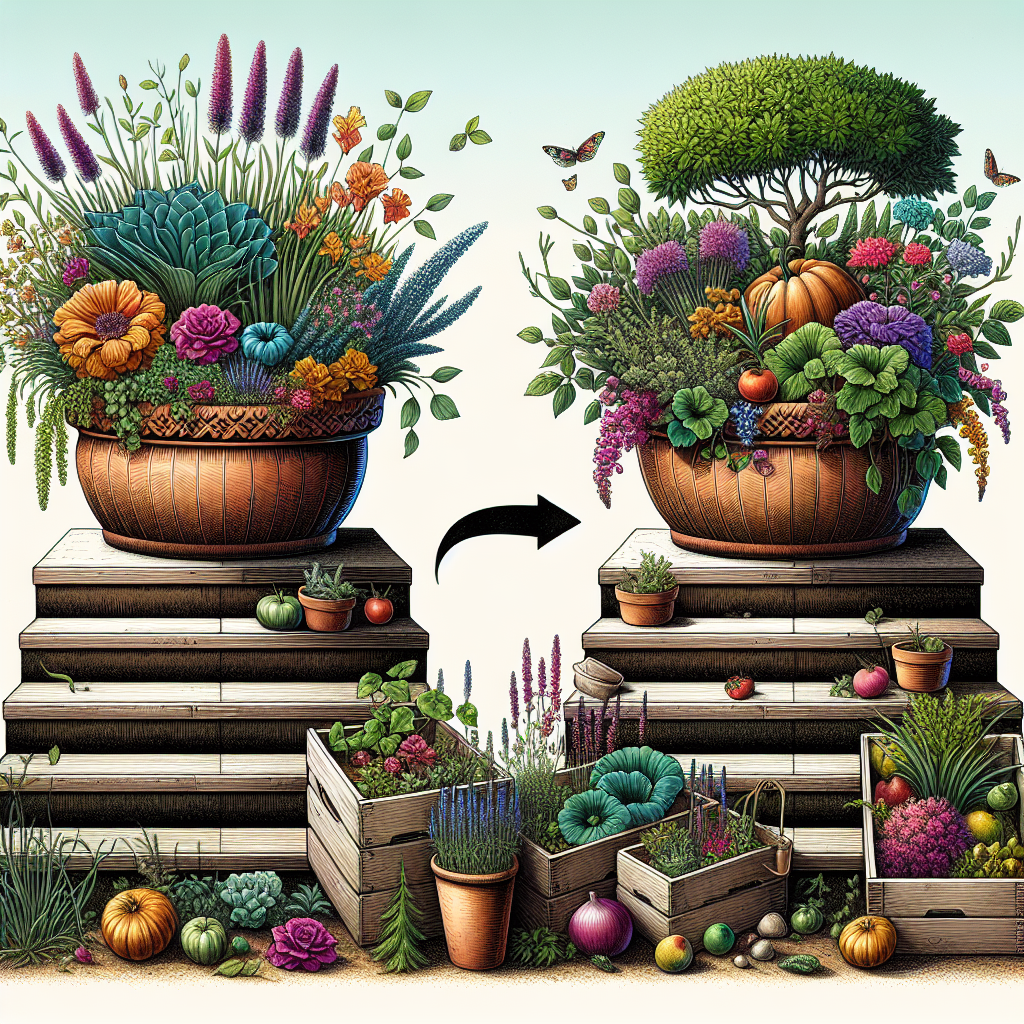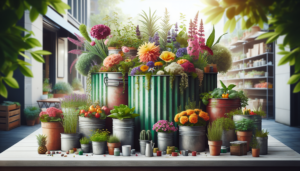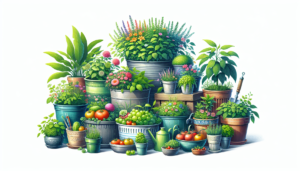
Imagine transforming a barren hill into a vibrant oasis of colorful flowers, luscious herbs, and thriving vegetables. With the art of container gardening, you can turn any sloping terrain into a stunning display of nature’s beauty. Whether you have a small or large hillside, this article will guide you on how to create a spectacular container garden that not only adds charm to your landscape but also utilizes space efficiently. Discover the secrets to successful container gardening on a hill and unlock the potential for a captivating outdoor sanctuary.
Choosing the Right Containers
When embarking on container gardening on a hill, it’s important to choose the right containers to ensure the success of your plants. One key factor to consider is the size of the container. Larger containers generally provide more space for root growth and allow for better moisture retention. However, smaller containers can also be suitable for certain plants, especially those with shallow root systems.
Another important aspect to keep in mind is proper drainage. Select containers that have drainage holes at the bottom to prevent water from pooling and causing root rot. Proper drainage is crucial to maintain the health of your plants and prevent waterlogged soil.
In addition to size and drainage, it’s wise to opt for lightweight containers when gardening on a hill. These containers are easier to move around, which can come in handy when you need to reposition them to optimize sun exposure or accommodate your plants’ growing needs.
Lastly, consider how the containers will complement the surrounding landscape. Choose containers that match the aesthetic of your garden and enhance the overall visual appeal. Whether you prefer sleek modern designs or rustic terracotta pots, the right containers can elevate the charm of your hillside garden.
Preparing the Hillside for Container Gardening
Before you can start planting, it’s essential to prepare the hillside for container gardening. Begin by evaluating the slope and direction of the hill. This will help determine the best layout for your containers and ensure optimal sun exposure for your plants.
Clearing the area of any debris or vegetation is the next step. Remove rocks, weeds, and other obstructions that may impede the growth of your plants or interfere with the containers. This will create a clean canvas for your container garden.
Leveling the ground as much as possible is crucial to create a stable foundation for your containers. Use a gardening rake or shovel to flatten out any bumps or uneven areas. A level surface will ensure that your containers sit securely and prevent them from tipping over or sliding down the hill.
To prevent erosion, it’s important to provide support for the hillside. Consider installing retaining walls or terracing to hold the soil in place. These measures not only help prevent soil erosion but can also add an attractive architectural element to your container garden.
Lastly, amend the soil to improve drainage and fertility. Mixing in organic matter, such as compost or well-rotted manure, can help loosen compacted soil, enhance water retention, and provide essential nutrients for plant growth.
Selecting Appropriate Plants
Choosing the right plants for your hillside container garden is crucial for their success. When selecting plants, take into account the sun exposure on the hill. Some plants thrive in full sun, while others prefer partial shade. Understanding the sunlight conditions will ensure that you choose plants that will thrive in your specific environment.
Consider the slope of the hill and the type of soil you have. Certain plants are better suited for slopes due to their aggressive root systems that help stabilize the soil. Additionally, some plants are more resilient in certain types of soil, such as those that are well-draining or can tolerate clay soils.
Opt for plants with shallow root systems, as they are better suited for containers. These plants are less likely to become root bound and will have an easier time adapting to the confined space of a container.
It’s important to select plants that have similar water requirements. This will make it easier to maintain a consistent watering schedule and prevent over or under-watering certain plants. Creating a harmonious balance in terms of water needs will ensure the health and vitality of your hillside garden.
To create visual interest, include a variety of plants in your container garden. Combine plants of different heights, colors, and textures to create a captivating display. Mix flowering plants with foliage plants to add depth and richness to your hillside garden.
Designing the Container Garden
Designing the layout and arrangement of your containers is an exciting part of container gardening on a hill. Start by planning the placement of your containers, taking into consideration factors such as sun exposure, ease of access, and aesthetic appeal. Experiment with different arrangements until you find the configuration that suits your vision.
Creating visual harmony through color and texture is essential in any garden, and container gardening is no exception. Select plants that complement one another and create a cohesive color palette. Consider contrasting textures, such as pairing soft and feathery foliage with plants that have bold, architectural leaves.
The height and cascading effect of plants can create a dynamic and visually appealing container garden. Place taller plants at the back or center of your containers, and position trailing or cascading plants at the edges to create a sense of depth.
Incorporate focal points or accents to add interest to your container garden. This could include decorative elements such as statues, trellises, or colorful ornaments. These focal points can draw the eye and create a focal point within your hillside garden.
Balance is key when designing your container garden. Distribute the containers evenly across the hillside to create a sense of equilibrium. Consider the overall composition and make adjustments accordingly to ensure a visually pleasing and well-balanced container garden.
Creating Sturdy and Secure Containers
Ensuring that your containers are stable and secure is essential, especially when gardening on a hill. One of the key aspects to consider is choosing the right potting mix. Opt for a mix that provides stability to the plants while also retaining moisture. A well-draining potting mix is ideal, as it will prevent water from pooling at the bottom of the containers.
Properly anchoring your containers on the hill is crucial to prevent them from sliding or tipping over. Use sturdy stakes or brackets to secure the containers in place. Make sure the stakes or brackets are firmly anchored in the soil to provide maximum stability.
Take into account wind and weather conditions when positioning your containers. If you live in an area prone to strong winds, consider placing the containers in a more sheltered spot or using additional support measures such as windbreaks or barriers.
Regularly inspect your containers and reinforce their stability as needed. Over time, the soil may settle or containers may become loose. Take the time to readjust and tighten any loose containers to maintain their stability and prevent accidents.
Watering and Maintaining the Container Garden
Proper watering and maintenance are essential for the health and vitality of your hillside container garden. Adjust the watering frequency based on the unique conditions of your hillside. Containers on a hill may dry out more quickly due to increased exposure to sun, wind, and drainage. Monitor soil moisture levels regularly and water accordingly to ensure your plants stay hydrated.
Apply a layer of mulch to conserve moisture in the containers. Mulch acts as a protective barrier, reducing evaporation and helping to maintain more consistent soil moisture levels. Organic mulch, such as shredded bark or straw, also adds beneficial nutrients to the soil as it breaks down over time.
Regular monitoring of the soil moisture levels is crucial to prevent over or under-watering. Use your finger or a moisture meter to gauge the moisture content of the soil. Adjust your watering schedule accordingly to provide the optimal moisture levels for your plants.
Fertilize regularly to promote healthy growth and vibrant blooms. Container-grown plants often require more frequent fertilization compared to those in the ground. Use a slow-release fertilizer or apply liquid fertilizer according to the manufacturer’s instructions. This will replenish the nutrients in the soil and ensure your plants receive the nourishment they need.
Pruning and grooming your plants help maintain their shape and appearance. Remove any dead or damaged foliage, and trim plants to encourage bushier growth. Regular grooming also helps to control pests and diseases by removing infested or diseased plant material.
Dealing with Erosion and Runoff
Erosion and runoff can pose challenges when gardening on a hill. Implementing erosion control measures is essential to prevent soil erosion and protect your container garden. Terracing or retaining walls are effective methods to stabilize the soil and prevent erosion. These structures divide the hillside into leveled sections, creating flat areas for planting and helping to hold the soil in place.
Planting ground-covering plants is another effective way to stabilize the soil and prevent erosion. These plants have a spreading habit and dense root systems that help bind the soil together. Select ground covers that are well-suited for your region and can tolerate the conditions on your hillside.
Installing gutters or channels can redirect water and prevent excessive runoff from reaching your container garden. Consider guiding water to more desirable areas, such as rain gardens or drainage systems, to avoid inundating your containers. Redirecting water can help prevent erosion and ensure that excess water is not damaging your hillside garden.
Utilize rain barrels or other water collection methods to capture rainwater and reduce water runoff. This provides a sustainable source of water for your container garden while also helping to minimize the impact on local water resources. Use the collected rainwater to irrigate your containers, further enhancing the eco-friendliness of your gardening practices.
Regularly inspect your hillside garden for erosion issues and address them promptly. Even with preventive measures in place, erosion can still occur. Keep an eye out for signs of erosion, such as exposed roots or soil being washed away, and take immediate action to mitigate the problem before it becomes more severe.
Pest and Disease Management
Pests and diseases can pose a threat to your container garden, but with proper management, you can keep them at bay. Start by identifying common pests and diseases in your area. Understanding the specific threats to your plants will help you implement effective preventive measures.
Proper spacing of your plants is an important preventive measure. Adequate spacing allows for good air circulation, preventing damp conditions that attract pests and disease. Regularly remove any dead or diseased plant material to minimize the risk of spreading infections.
Utilize natural and organic pest control methods whenever possible. These methods are safer for the environment and your plants while still effectively managing pests. For example, introducing beneficial insects, such as ladybugs or lacewings, can help control aphid populations.
Regularly inspect your plants for signs of infestation or disease. Look for common symptoms like yellowing leaves, distorted growth, or the presence of pests. If you notice any issues, take immediate action to control and treat the problem before it spreads to other plants.
Taking a proactive approach to pest and disease management will help keep your container garden healthy and thriving. Regular monitoring, preventive measures, and timely intervention are the keys to successfully managing pests and diseases.
Winterizing and Protecting the Container Garden
With the arrival of winter, it’s important to take steps to protect your container garden from the cold temperatures and harsh conditions. The first consideration is choosing winter-hardy plants that can withstand freezing temperatures. If you have plants that are not cold-tolerant, consider relocating the containers indoors before the first frost.
Applying mulch or protective coverings can help insulate your plants and offer them some protection against the cold. Layering mulch around the base of the plants helps to maintain soil temperatures and prevent frost from reaching the roots.
During freezing temperatures, it’s important to avoid excessive watering. The excess water can freeze and cause damage to the roots. Adjust your watering schedule accordingly to provide sufficient moisture without overwatering.
Provide shelter from harsh winds and frost by moving your containers to a more sheltered area, such as against a wall or under an overhang. This can help reduce the impact of cold and reduce the risk of plant damage.
Winter care for your container garden should be monitored and adjusted as necessary. Regularly check the moisture levels, monitor for any signs of cold damage, and make any necessary adjustments to protect your plants. With proper winter care, your hillside container garden can emerge robust and vibrant in the spring.
Troubleshooting Common Challenges
Container gardening on a hill can present unique challenges, but with the right approach, these challenges can be overcome. Poor drainage is a common issue that can be addressed by ensuring proper drainage in your containers. Choosing containers with drainage holes, using well-draining potting mix, and regularly inspecting for any signs of waterlogging can help mitigate this challenge.
Excessive moisture can also be a problem, especially if your containers are positioned at the bottom of the hill where water tends to accumulate. To combat excessive moisture, consider elevating your containers on pedestals or using risers to improve airflow and drainage.
Preventing soil erosion and shifting of containers can be achieved through proper anchoring and support. Use stakes, brackets, or other anchoring methods to keep your containers secure on the hillside. Regularly inspect the stability of your containers and reinforce as needed to prevent any accidents or damage.
Nutrient deficiencies or imbalances can occur in container gardens, particularly when using the same potting mix for an extended period. To manage these issues, regularly fertilize your plants with a balanced fertilizer or use organic amendments to replenish the nutrients in the soil.
Revive and rejuvenate tired or struggling plants by providing them with proper care and attention. Adjust their watering schedule, fertilize as needed, and consider pruning or grooming to remove any dead or damaged growth. With a little extra care, your plants can bounce back and thrive in your hillside container garden.
Container gardening on a hill can be a rewarding and engaging experience. By carefully choosing the right containers, preparing the hillside, selecting appropriate plants, designing the layout, ensuring container stability, providing proper care, managing erosion and pests, protecting your garden in winter, and troubleshooting common challenges, you can create a beautiful and thriving container garden on your hillside. Enjoy the process, and embrace the beauty of your hillside container garden as it flourishes throughout the seasons.







